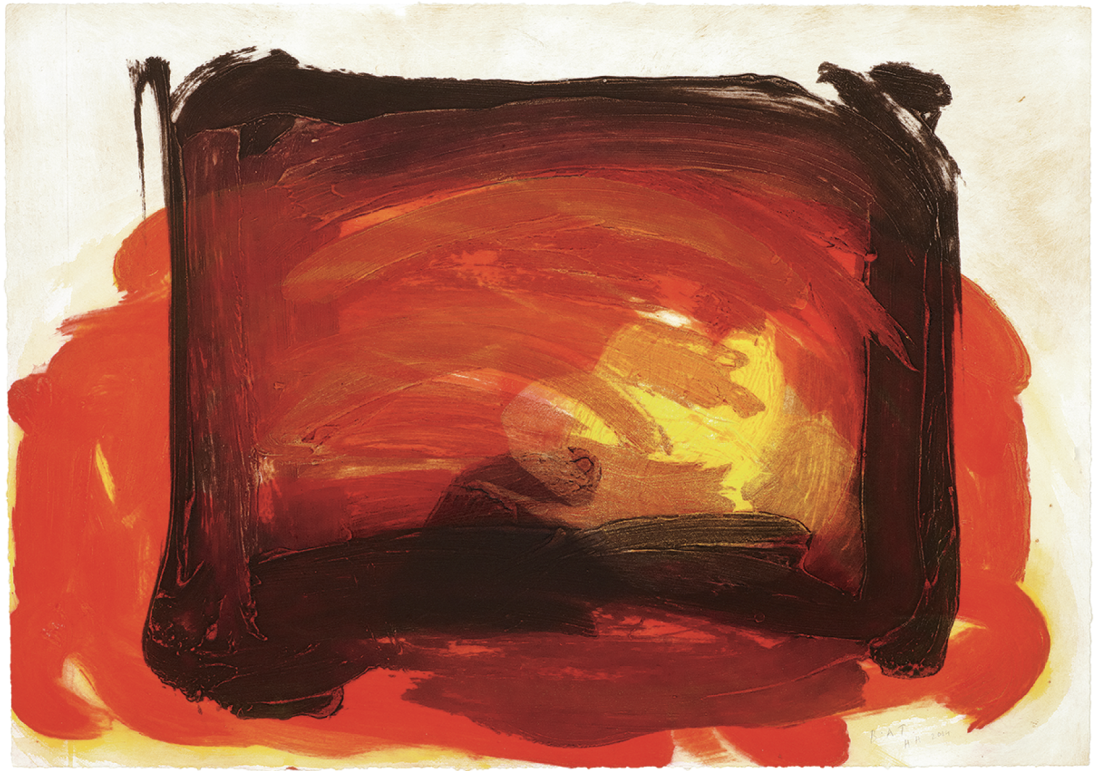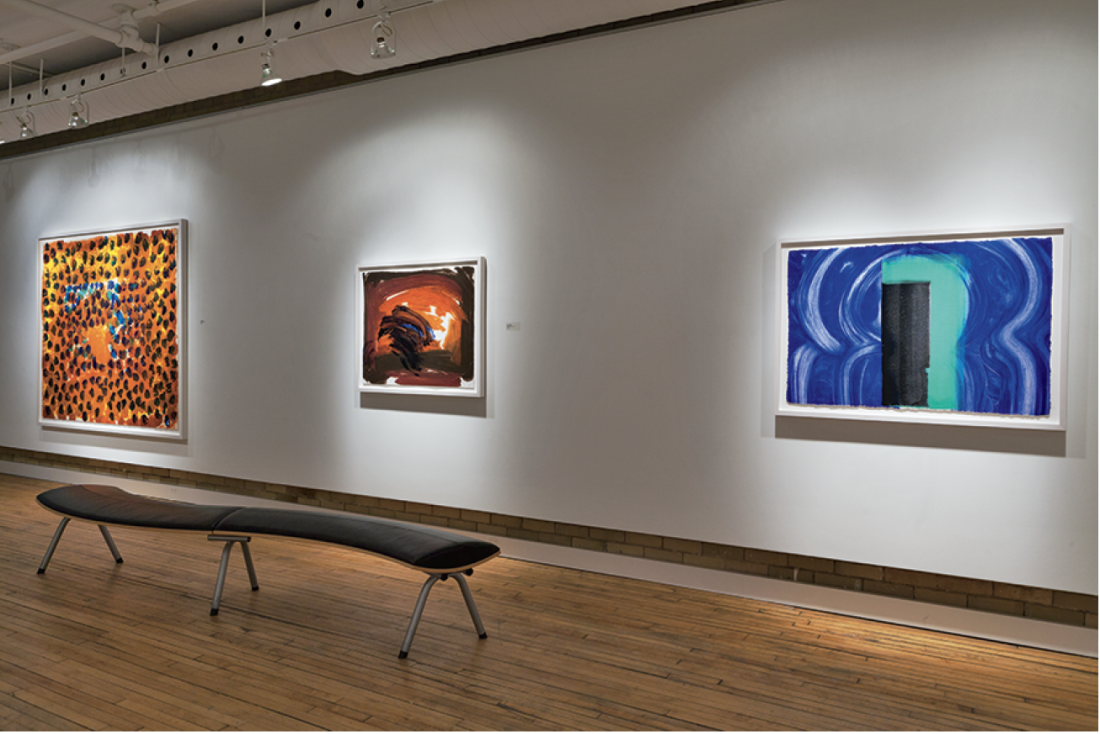Howard Hodgkin
American writer Josh Cohen, in a recent piece for newstatesman.com, said about Slavoj Žižek’s 2014 book, Absolute Recoil: “Žižek has been cautioning us for a long time to be suspicious of authentic spontaneity and has endeavoured to show us that every manifestation of life is secretly conditioned by its obverse. This is the essential and obsessively iterated point of Absolute Recoil. The term is Hegel’s (absoluter Gegenstoss) and describes the “radical coincidence of opposites in which the action appears as its own counteraction…in which the negative move (loss, withdrawal) itself generates what it negates.” Printmaking is an unlikely demonstration of the truth of this; apparent spontaneity produced in editions, counteraction appearing as action to generate an image; loss as a generative and integral step in the process—even the recoil suggesting the squeeze and release of the press.

Howard Hodgkin, Summer Evening, 2014, hand-painted carborundum relief from 2 plates printed sequentially with Titanium, White, Fonce Yellow/Warm Sepia/Citron Yellow/Apricot/Crimson/Cardinal Mix, Van Dyke/Bistre Brown/Sanguine mix, hand-painted with a Diarylide Yellow wash on Moulin Du Gué 350 gsm paper, 34.5 x 49 inches, edition of 18. © Sir Howard Hodgkin and Alan Cristea Gallery. Image courtesy Nicholas Metivier Gallery, Toronto.
Howard Hodgkin’s prints at the Nicholas Metivier Gallery in Toronto appear to be spontaneous. For example, the huge In India from 2012 looks at first glance like 50 square feet of hot splashed yellow, orange and crimson—a sumptuous giant watercolour. But these are four copperplates treated with a sugar solution and acid to produce aquatints in an edition of 10. Action, counteraction and generation by negation are fundamental to this process, where the gestural mark-making of painting is managed through the printer’s studio (for the recent work seen here, that studio is Andrew Smith’s). At the same time as the Metivier show, there are eight of Hodgkin’s paintings on view a few kilometres up the Don Valley Parkway at the Aga Khan Museum (along with Hodgkin’s collection of Mughal pictures, including the so-called “Hodgkin’s Elephants”). In his paintings, Hodgkin is authentically and, perhaps for Žižek, suspiciously spontaneous; the loaded brush produces a gesture—the repeated irregular spots in Autumn in Bombay of 2013–2014 are examples. All is there to be seen, the size of the tool, the consistency of the paint, the chromatic saturation. The moment of making is captured, held for us to regard. The prints, however, are anything but what they seem; the image of a mark appears to have a physical dimension, raised from the paper. But it’s not so, of course—the relief on the etched plate is creating the illusion of that materiality. The process is elaborately technical: sugar solution or a mixture of carborundum (silicon carbide used to grind lithography plates) and glue are partially dissolved by water, just as other parts of the aluminium or copperplate are protected by a “resist.” The production, encompassing the preparation of the plates as well as the application of the colours, is a stage-by-stage process. It must begin essentially as a re-creation, or revivification of another process in Hodgkin’s work—that of making a painting—but the prints undoubtedly take on different characteristics of their own.
There is plenty of shared compositional territory between Hodgkin’s paintings and prints; he has been painting an echo of the rectangle of the support for many years and it appears in several of the works here. It’s a portal of some kind, a window or a frame, a loose structure that allows perceptual flexibility in referring to a perspective of being inside looking out or outside looking in. In the 2014 prints on show here, we find “outlookers” in Sundown and Storm Cloud and a potential “in looker” in For Alan VII. The ambiguity of these spaces and the relative abstraction of the prints allow the artist to get at the central concern of all we see at Metivier—and indeed all of his work; colour interiors for Hodgkin do not include having to deal with the mechanics of still-life painting, a stack of fruit on a plate placed on a table, for example. Just the descriptions of the applications of inks in the production of these prints give a sense (a flavour!) of the richness of the visual experience: three plates printed sequentially… Citron Yellow… Apricot… Crimson… Bistre Brown…. In his palette of inks, Hodgkin is a sybaritic artist; a Londoner susceptible to the lure of travel and the exotic. He has spoken of the relationship of both observation and memory to his work. The paintings and prints are an attempt to recreate the experience of a particular evening, say, and to make a sense of that experience available to the viewer. The visual clues suggest the place as opulent, the circumstance—seduction. These prints do this by the selection and conjunction of colours more than in any other way; their chromatic purity here, their impurity there, as he mixes wet-into-wet, one with another. Colour is evocative; it seeks to and demands an emotional response: the aqueous blue of Venice Afternoon, the glowing red/orange in Summer Evening, the varying saturations of spots of ink in one of the smaller prints, Grass.

Howard Hodgkin, installation view, “Hand Painted and Relief Prints: 1990–2014,” 2015, Nicholas Metivier Gallery, Toronto. Image courtesy Nicholas Metivier Gallery.
Hodgkin is an artist for whom tradition appears to be generative; the influence of Vuillard and Bonnard, for example, taking us to the vitality of an age of competing salons, replaying the last great flowering of cutting-edge representational painting. (To mention these artists reminds us of their extraordinary treatment of interiors—and that is Hodgkin country too, of course). The French tradition encounters colour from post-war American art in these prints, a certain chromatic licence exemplified by the work of Hans Hofmann or Sam Francis, perhaps. As a result, Hodgkin is a reassuring artist, one who asserts the value and legitimacy of traditions, both the elevation of private life we find in post-Impressionism and the emancipatory experiential freedom of abstraction. This has been the line taken by his critics. It’s over 20 years since Stuart Morgan described Hodgkin as the painterly equivalent of the novelist Anita Brookner (in an attempt to skewer them both), declaring his paintings formulaic and unconvincingly detached from their time; tradition as a weight, rather than as a springboard. Slavoj Žižek might regard this lineage of Hodgkin’s work as symptomatic. For Žižek, aesthetic artefacts are treated as symptoms of the culture in which they are produced. These hand-painted and relief prints, then, are examples of art as refuge, images that underline cultural certitude in a time of uncertainty and upheaval. Perhaps that is so, but as a colourist, demonstrated by these prints, Hodgkin is hard to resist. ❚
“Hand Painted and Relief Prints: 1990–2014” was exhibited at Nicholas Metivier Gallery, Toronto, from March 5 to March 28, 2015.
Martin Pearce makes paintings and drawings. He teaches in the School of Fine Arts and Music at the University of Guelph.

